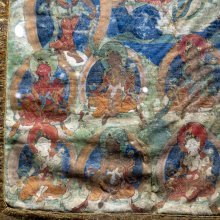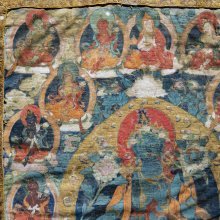Ekavimshati, Ekaviṃśati, Eka-vimshati: 8 definitions
Introduction:
Ekavimshati means something in Buddhism, Pali, Hinduism, Sanskrit. If you want to know the exact meaning, history, etymology or English translation of this term then check out the descriptions on this page. Add your comment or reference to a book if you want to contribute to this summary article.
The Sanskrit term Ekaviṃśati can be transliterated into English as Ekavimsati or Ekavimshati, using the IAST transliteration scheme (?).
Images (photo gallery)
In Hinduism
Shaivism (Shaiva philosophy)
Source: ORA: Amanaska (king of all yogas): (Shaivism)Ekaviṃśati (एकविंशति) refers to “twenty-one” (generations), according to the Śivadharmottara: an ancient Sanskrit text dealing with the merit generated by ritual action and methods for attaining rewards after death.—Accordingly, “If [the king] performs this rite [of worshipping the Liṅga] with its six factors Śiva will show his favour. In both this world and the next he will grant all his desires. So a king who is a devotee of Śiva should worship him in this way. If he does so he will rescue twenty-one (ekaviṃśati) generations of his patriline. He will install them in heaven and then go on himself to the eternal domain of Īśvara...”.

Shaiva (शैव, śaiva) or Shaivism (śaivism) represents a tradition of Hinduism worshiping Shiva as the supreme being. Closely related to Shaktism, Shaiva literature includes a range of scriptures, including Tantras, while the root of this tradition may be traced back to the ancient Vedas.
Sports, Arts and Entertainment (wordly enjoyments)
Source: archive.org: Syainika Sastra of Rudradeva with English Translation (art)Ekaviṃśati (एकविंशति) refers to “twenty-one (horsemen)” (accompanying a hunting party), according to the Śyainika-śāstra: a Sanskrit treatise dealing with the divisions and benefits of Hunting and Hawking, written by Rājā Rudradeva (or Candradeva) in possibly the 13th century.—Accordingly, [while discussing the outlines of hawking]: “[...] At the middle of the party there should be the leading hawker, with two soldiers on each side. The circle should be made with twenty-one (ekaviṃśati) horsemen. All men in the circle, with their eyes fixed on the chief hawker, should remain at a distance of four cubits from each other, in two equal divisions on each side. [...]”.

This section covers the skills and profiencies of the Kalas (“performing arts”) and Shastras (“sciences”) involving ancient Indian traditions of sports, games, arts, entertainment, love-making and other means of wordly enjoyments. Traditionally these topics were dealt with in Sanskrit treatises explaing the philosophy and the justification of enjoying the pleasures of the senses.
In Buddhism
Mahayana (major branch of Buddhism)
Source: De Gruyter: A Buddhist Ritual Manual on AgricultureEkaviṃśati (एकविंशति) refers to “twenty-one (figures)” (suitable for an offering ritual), according to the Vajratuṇḍasamayakalparāja, an ancient Buddhist ritual manual on agriculture from the 5th-century (or earlier), containing various instructions for the Sangha to provide agriculture-related services to laypeople including rain-making, weather control and crop protection.—Accordingly, [As the Bhagavān said]: “Now I shall teach the offering manual which is auspicious and can bring about any effect. [...] Seven coiling figures should be made and rice spirals. Twenty-one figures (ekaviṃśati-rūpaka) should be prepared one after the other. Boiled rice, milk rice, a dish of rice and peas, yoghurt and thickened milk should be placed. Fruits and flowers should be placed. Four jars should be placed. Preceded by a great offering barley-meal should be placed as foremost. [...]”.

Mahayana (महायान, mahāyāna) is a major branch of Buddhism focusing on the path of a Bodhisattva (spiritual aspirants/ enlightened beings). Extant literature is vast and primarely composed in the Sanskrit language. There are many sūtras of which some of the earliest are the various Prajñāpāramitā sūtras.
Languages of India and abroad
Sanskrit dictionary
Source: DDSA: The practical Sanskrit-English dictionaryEkaviṃśati (एकविंशति).—f. twentyone.
Derivable forms: ekaviṃśatiḥ (एकविंशतिः).
Ekaviṃśati is a Sanskrit compound consisting of the terms eka and viṃśati (विंशति).
Source: Cologne Digital Sanskrit Dictionaries: Benfey Sanskrit-English DictionaryEkaviṃśati (एकविंशति).—f. twenty-one, [Mānavadharmaśāstra] 4, 87.
Ekaviṃśati is a Sanskrit compound consisting of the terms eka and viṃśati (विंशति).
Source: Cologne Digital Sanskrit Dictionaries: Monier-Williams Sanskrit-English DictionaryEkaviṃśati (एकविंशति):—[=eka-viṃśati] [from eka] f. twenty-one, a collection or combination of twenty-one, [Taittirīya-saṃhitā; Śatapatha-brāhmaṇa]
[Sanskrit to German]
Sanskrit, also spelled संस्कृतम् (saṃskṛtam), is an ancient language of India commonly seen as the grandmother of the Indo-European language family (even English!). Closely allied with Prakrit and Pali, Sanskrit is more exhaustive in both grammar and terms and has the most extensive collection of literature in the world, greatly surpassing its sister-languages Greek and Latin.
See also (Relevant definitions)
Partial matches: Vimshati, Eka.
Starts with: Ekavimshaticchadi, Ekavimshatidha, Ekavimshatirupa, Ekavimshatirupaka, Ekavimshatisamstha, Ekavimshatisthana, Ekavimshatisthanaka, Ekavimshatitama, Ekavimshatividha.
Full-text: Ekavimshatitama, Ekavimshat, Ekavimshatividha, Ekavimshatidha, Ekavimshaticchadi, Samdhya, Aratni, Ekavimsha, Vela.
Relevant text
Search found 5 books and stories containing Ekavimshati, Ekaviṃśati, Eka-vimshati, Eka-viṃśati, Ekavimsati, Eka-vimsati; (plurals include: Ekavimshatis, Ekaviṃśatis, vimshatis, viṃśatis, Ekavimsatis, vimsatis). You can also click to the full overview containing English textual excerpts. Below are direct links for the most relevant articles:
Vakyapadiya of Bhartrihari (by K. A. Subramania Iyer)
Verse 3.11.20 < [Book 3 - Pada-kāṇḍa (11): Saṅkhyā-samuddeśa (On Number)]
Verse 3.11.22 < [Book 3 - Pada-kāṇḍa (11): Saṅkhyā-samuddeśa (On Number)]
Sahitya-kaumudi by Baladeva Vidyabhushana (by Gaurapada Dāsa)
Text 7.52 < [Chapter 7 - Literary Faults]
Tattvartha Sutra (with commentary) (by Vijay K. Jain)
Verse 2.2 - Various kinds of disposition (bhāva) < [Chapter 2 - Category of the Living]
Baudhayana Dharmasutra (by Georg Bühler)
The Padma Purana (by N.A. Deshpande)
Chapter 31 - Vikuṇḍala’s Dialogue with the Devadūta < [Section 3 - Svarga-khaṇḍa (section on the heavens)]



